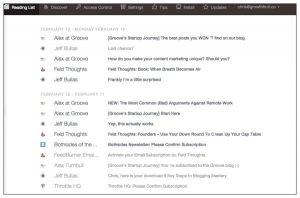Welcome to the first in a series of what to test and why with email marketing. It’s said that timing is everything and, given the change in the way we access our emails and the online world generally, it’s now even more important to send the right message at the right time.
I’ve read a few posts lately saying 2015 is the year of customer experience, where marketers will put the customer first and create a positive experience from initial contact through to purchase and beyond. The other ‘big thing’ for this year is for marketing to become truly omni-channel. The drivers for these remain unchanged; fear and greed. Fear over rival brands stealing a march and customers, fear over the wealth of information available to consumers, the choice and availability of products and peer and ‘professional’ reviews about quality, price and service. However, get all of your marketing efforts singing and dancing in unison and they will translate into increased user engagement, a better brand experience for your customers and more revenue – even if this does mean that brands, and their marketing teams, need to be pretty much everywhere all the time.
The reason improving your marketing email timing is becoming increasingly important is because we live as much in the online world as we do in the offline one, by which I mean we are always connected, always checking our phones, tablets and computers and we do throughout the day. We all do it, just look around on your daily commute, or when your waiting for your coffee, or when your pretty much anywhere doing anything. Online and offline are becoming difficult to separate and this presents opportunities for marketers who get it right. So where does email sit in the mix and what are the best days and times to send them?
There are many reports about the best time to send emails and most of the timeline graphs we see show a classic steep and immediate curve of opens as soon as a campaign is deployed, followed by a similar curve back down with peaks in the evening and smaller ones in the morning and around lunchtime. Opens then bubble along at low levels for a few more days. However, for B2C emails open times can be as unique to you as your data is, which means the way to find out who responds best to your emails at different times is through testing.
Manual labor
For our bread and butter email campaigns (and I don’t mean ‘bulk’ as you can be as targeted as your recipients would like you to be by using segmentation and dynamically generated content) we can take a look at when email campaigns used to be sent and test to see if those days and times have relevance today and what you can do to make sure your emails land at the right time.

People power
Understanding your audience is the single most important thing you can do for email marketing success. These are people that have signed up to receive your emails, spent time on your website and bought your products and services – you should know their habits and cater to them.
Day and night
While this one may be obvious, it’s usually better to send out your email campaigns during the day when most of us are awake. However, we do see activity every hour of the day in terms of open and clicks so see if your night birds are always the same and test sending to those people later.
I don’t like Mondays
The general consensus is to avoid sending marketing emails on Mondays. Why? Apparently people are grumpy as it’s not the weekend any more. Well, if that’s true than what better time to send out a feel good email about a holiday, short break or message suggesting people get over the Monday morning blues by planning for the next weekend?
Friday fever
Are we really all so de-mob happy on Friday afternoons that we ignore emails? Apparently we used to be that way but the ubiquity of the online world means this is no longer the case and, even if we are all desperate to get to the pub early, Friday afternoon is still a good time to send emails about weekend entertainment, shopping ideas and betting opportunities for sporting events.
Midweek mayhem
Tuesday, Wednesday, and Thursday have traditionally been favored send days, as email marketers seek to avoid the Monday angst and Friday’s itchy-feet. Stats from MailChimp confirm Tuesday and Thursday as the two most popular days to send marketing emails which, of course, raises the issue of how to get noticed in a crowded inbox. Midweek is as good a place as any to start and can be used as your point of reference when you start to test other days.
 Larking about
Larking about
Most of us are up early to get to work whether we’re bright and breezy larks or late night owls. And what do we do on our commute? We are absorbed in our smartphones. The evidence of thousands of people sat in a train, tube or bus (even car, naughty!) is supported by the timeline graphs we see showing a noticeable increase in opens between 06:00 and 09:30.
Two hour difference
I recently ran some tests with a training course client who were sending their marketing emails at 10 a.m. We ran tests with 10 percent of their data sending at 8 a.m. and the uplift in opens and clicks was 50 percent in London and Edinburgh and between 20 percent and 40 percent for Manchester, Birmingham, and Leeds. Similarly, a retail client switched their sends to 7 a.m. and also saw increases in open rates. This shows how important that ‘commute’ time is in reaching people.
Middle ground
The middle of the day has always been popular too (11 a.m. to 3 p.m.) It’s time-honored, safe, even reliable and so not a bad starting point. However, smartphones and tablets have changed the game completely so start testing either side of this and keep testing earlier and later to see where the drop off gets reaches tipping point.

Living for the weekend
The days of no-one looking at emails at weekends are long gone. Saturday and Sunday are now often the best days for people to interact with emails. In fact most ‘days off,’ e.g. Christmas, show high email open and click / tap rates.
For a limited time only
Around a quarter of emails are opened within an hour of being sent but there are people that may not see to your email for a day or two (hard to believe these days I know!) so for time sensitive campaigns give at least three days notice or, better yet, send an email three days beforehand and a reminder the day before.
Ageism
Segmenting data by age groups, even broad ones, can highlight variances in the times of open and click rates. In sends for a car insurance client we saw increased engagement in the evening and early morning for the over 40s. The lowest group for engagement were the under 25s – particularly in the morning. Ahh, to be under the age of 25 again! These engagement levels were reflected in overall opens and clicks which may be a reflection of the cost of car insurance for the younger age bracket so the rule, as always, is to caveat any test results with ‘what else might be responsible for this?’
Upwardly, downwardly, sidewaysly mobile
Okay, so sidewaysly isn’t a word (not sure that downwardly is either!) but the point here is that we are so connected now that we are almost always online. Hands up who checks their emails first thing in the morning, last thing at night and a whole bunch of times times in between? Yes, we also look at websites and social sites, play games and read books, listen to music and catch up with TV and movies but the biggest usage of our smart devices is still email – three quarters of us say so. Personalize me
Personalize me
In much the same way that email marketers personalize email content based on what they know about us, we can start to do the same in terms of the times we send emails. We know what time people signed up on our sites, we know when people visit various web pages and when purchases are made. Collate and analyse this data, look for patterns and start testing these send times with segments of your data and record the results.
Top of the tree
Analyzing who opens emails at what time affords us the choice of sending emails at these times. Chances are your email will be at the top of the inbox right when people are looking, something that will become increasingly important for Gmail users when Google finally launches Grid View.
Trigger happy
There’a a lot of evidence to support automated emails outperform manually sent campaigns and the main reasons for this are relevance in terms of content and timing.
For emails triggered by an event such as a user action or date, the timing of a send is pre-determined – but that doesn’t mean that testing shouldn’t be done. Some triggered emails should be instant, such as welcome emails on sign-up and confirmations on transactions (be they purchases, white paper downloads etc.) and form submissions for enquiries.
Others, such as follow-up emails in a welcome email sequence and basket recovery emails need more thought as they are dependent on what product or service you’re selling, your audience and how many emails are in the sequence. Three emails for a welcome campaign and two for basket recovery should suffice in most instances but this number can be tested – just be aware that you have enough relevant things to say and that you don’t alienate your audience with too many reminders.
Basket case
For basket recovery, smaller ticket items need emails sent within 30 minutes to an hour. For larger items, particularly holidays, around 24 hours works better as it gives people time to discuss with partners or friends and book the time off work. If this email doesn’t convert the sale then a follow up email three days later offering assistance via a help desk can also work well.
 Celebrate good times
Celebrate good times
For birthdays, anniversaries and other key dates you have for you customers, the timing can be influenced by what you are selling, so for entertainment and leisure companies anything up to a month in advance is a good idea so the birthday boy or girl can organize the day well in advance, ideally bringing along lots of family and friends.
Virtuous circle
Your triggered emails shouldn’t end at confirmation or even delivery notices. Amazon send multiple emails about delivery and follow up a few days later with review requests, although they could have more personality like those from ASOS. ‘After care’ emails give people the feel good factor and can also be used to cross sell, promote other products, and offer incentives. One of our retail clients rewards first time buyers with a thank you email containing a 10 percent discount code for their next purchase and this email consistently achieves open rates in excess of 70 percent.
The time is now
Real time content in emails has been a reality for the last two years or so, with companies like Moveable Ink and Liveclicker’s RealTime Email. Using HTML5 it’s possible to insert and change content in emails, even after they have been sent. You can embed video that will play from the email, serve images relating to when and where the email is opened using geo-location (a sale in a nearby store with a countdown timer followed by lunch in a local restaurant, oh and here’s a coupon for both!) – you can even include a map to help people get there and a weather forecast to inspire that umbrella purchase. You can also serve in portions of your website, blogs and live social media comments for peer reviews and recommendations – although social media commentary should be monitored to avoid a potential PR disaster!
Emails like these are about as timely as you can get and update every time they are opened, driving user engagement and improving that all important customer experience.
Open vs. click vs. site visit
One thing we have seen increasing over the last two years is the disparity between opens and clicks. The click-to-open rate metric, once so popular, has become an unreliable way to view email campaign success. Some of the environments in which we open our emails now just aren’t conducive to reading them, clicking (or tapping) and then doing the thing you want us to do on the website. Click and taps tend to be higher in the evening and at weekends when people have more time in a more relaxed environment. And, of course, we don’t suddenly switch to laptops and desktops when we get home, our ‘phones and tablets are very often our default devices wherever we are – it’s just more convenient.
 Ball of confusion
Ball of confusion
Whilst we have better tools to measure how and when people are interacting with emails, making sense of this data is increasingly difficult due to the myriad of devices in use and locations people are in. Just because someone opened an email on a desktop at 7 p.m. today doesn’t mean they won’t open your next email at 7 a.m. on a mobile device. So patterns and trends are harder to identify and are constantly shifting, but they are there and testing will reveal them.
The best of times, the worst of times
Today’s omni-channel, multi-device, always connected world means marketers will have to look harder for the optimal send times as well as constantly testing to see if what was true last month is still true this month. It’s important to keep track of what’s working and what isn’t so create a matr ix as you test, plotting your KPI’s so you have a record of any differences in performance. Try and keep all other variables constant so you can be sure these differences are because of the send time. This will become one of the weapons in your email armoury to help improve your email response rates overall.
ix as you test, plotting your KPI’s so you have a record of any differences in performance. Try and keep all other variables constant so you can be sure these differences are because of the send time. This will become one of the weapons in your email armoury to help improve your email response rates overall.
In conclusion, it’s clear the time an email lands in the inbox is more important than ever. It’s one of the three things that determine if an email is opened (the other two being brand recognition and an inspiration subject line). As marketers, the more we can fine tune email sends to land at the right time the better we will engage people, the higher the value they will place on our brand, the more they will visit our websites and the more they will buy – so get yourself a plan and start testing!
(274)







